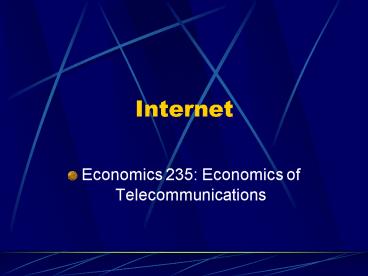Internet - PowerPoint PPT Presentation
1 / 40
Title:
Internet
Description:
ARPAnet - late 60's Advanced Research Projects Administration ... Qwest. 1,120,000. Sprint. 550,000. Covad. 550,000. Total North America. 14,700,000. New Plans ... – PowerPoint PPT presentation
Number of Views:47
Avg rating:3.0/5.0
Title: Internet
1
Internet
- Economics 235 Economics of Telecommunications
2
What is the Internet?
- Worldwide network of computer networks that use
TCP/IP protocols.
3
Where did the Internet come from?
- ARPAnet - late 60's Advanced Research Projects
Administration - Defense Dept., contractors and
universities. - NSFnet - mid 80's linked universities and
supercomputer centers. - Privatized as of April 30, 1995
4
Modularity and Layering
- Modularity managing complexity by enabling
different products to work together through well
understood rules. - Layers
- Physical layer millions of networked computers
joined together - Logical Layer common computer addressing scheme
and protocols TCP/IP - Application layer email/WWW
5
How big is it?
6
(No Transcript)
7
(No Transcript)
8
(No Transcript)
9
(No Transcript)
10
(No Transcript)
11
(No Transcript)
12
(No Transcript)
13
Who runs it?
- No one.
14
Circuit switching vs. Packet switching
- Why do data networks use packet switching?
15
Pricing Internet access (current Small End
Users)
- Connection pricing - fixed bandwidth connection
with unlimited usage up to the max. - Marginal packet is priced at zero.
16
Economic Problems
- Over-utilitizing PSTN with Internet
- Congestion on the Internet
17
Local Network Problems
- Data from Pacific Telesis 1995
- Avg voice call is 3.8 minutes
- Avg Internet connection is 20.8 minutes
- 10 of Internet calls last 6 hours or more
- Peak hour is 10 pm not daytime
- LECs called for Access Charge pricing for ISPs
18
(No Transcript)
19
(No Transcript)
20
(No Transcript)
21
(No Transcript)
22
Local Network Solutions
- People starting buying second lines increasing
LEC revenue - ADSL shifts burden from PSTN and enhances LEC
revenue even more
23
Congestion on the Internet
- Problem of commons/externality
- Each packet that I send imposes a cost on all
other users because the resources that I am using
are not available to them - may result in delay
or lost packets.
24
Non-Price Mechanisms to control congestion
- Prioritize packets/impossible to enforce
- Voluntary efforts to reduce usage
- Over provisioning to handle peak demands
25
Pricing Mechanisms to control congestion
- Usage-based pricing
- Committed Information Rate pricing (CIR)
- Expected Capacity Price
26
Usage-based pricing - Difficulties
- Accounting for each packet is infeasible
- Want to track individual user who is causing the
cost can only track host computer. - People have a flat rate bias
27
Committed Information Rate pricing (CIR)
- Two part tariff
- Price based on connection fee (flat fee)
- Price based on guaranteed flow to customer
- Committed Information Rate is the amount sent to
a single user if all users were on the network /
worst case rate
28
What should be priced?
- Three main elements of costs - prices should be
matched to costs - Cost of connecting to the net. Already priced.
- Cost of providing additional network capacity.
Charge organization for usage during the peak
time. - Social cost of congestion. Vickrey auction - bid
for packet to go thru - all charged lowest bid
price that went thru.
29
How much would a Vickrey Auction cost?
- Less than .50/person/month.
30
Non-Congestion Pricing
- Once capacity is in place, direct usage and is
negligible by itself not worth charging for given
accounting and billing costs. - ISP's local access same as switched access but
price discriminated.
31
32
Broadband to the Home
- Cable Modems
- ADSL
33
(No Transcript)
34
(No Transcript)
35
Cable Modems ATT and Open Access
- Residential neighborhoods
- Shared
36
Major Cable Modem Providers by Subscribership, Q1
2005
37
- Distance from CO
- Ubiquitous
- Res Bus
38
Major DSL Providers by Subscribership, Q1 2005
39
(No Transcript)
40
New Plans
- ATT is using FTTN (Fiber to the Node) 250 per
subscriber predicting 20 penetration for
IP-based video services - Verizon is using FTTP (Fiber to the Premises)
1,100 per subscriber































